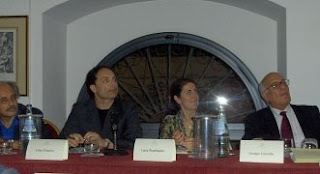
Last night, in the splendid surroundings of Modica's Hotel Palazzo Failla, I attended the launch of the journalist Fabio Pompeo Iacono's collection of articles, L'Occhio Siderale. The book was published and the event organised by the Caffè Letterario Quasimodo:


Above: The Hotel Palazzo Failla.


Above: Fabio Pompeo Iacono and panel; Fabio Pompeo Iacono.
A very interesting evening ensued for, instead of the usual format of an introduction to the author's work by several experts and then a reading by the author himself, Fabio Iacono invited audience comment and questions and everything from the state of Modica today to the nature of journalism was discussed.
Let me give you a flavour of Fabio Iacono's writing [I quote here with his permission]:
"Si, gli edifici più antichi cercano di spiegare le loro ragioni ai presenti, ma quasi nessuno li ascolta. Se non fosse stato per il tradimento degli uomini e della natura matrigna che nel 1902, per mezzo di due torrenti impetuosi, volle spazzare via tante vite con la conseguente eliminazione dei loro letti, oggi Corso Umberto 1, con i suoi ponticelli, sarebbe una piccola Venezia, un cioccolatino irresistibile per connazionali, francesi, tedeschi ed europei in genere.
Yes, the oldest buildings [in Modica] try to explain their existence to the newer ones, but hardly anyone listens. Had it not been for the treachery of man and harsh nature, which, by means of two raging torrents in 1902, decided to sweep away so many lives along with the subsequent destruction of the river-beds,* the Corso Umberto 1, with its bridges, would today be a little Venice, an irresistible, precious chocolate for fellow-Italians, French, Germans and Europeans in general."
* The river was paved over after the terrible flood of 1902.
I very much like this style of writing, in which one can imagine the lovely old buidings having feelings and wanting to speak to us. The image of Modica as a "cioccolatino" , a reference, of course, to its current fame as the home of pure chocolate, is, I think, a delightful one.
During the discussion it emerged that what strikes Fabio Iacono about the south is its reluctance to change and this is something to which I have referred many times on this blog. To me this is both a good and a bad thing, for, whilst it means that culinary, religious and family traditions are, for the most part, preserved, it also leads to a "culture of acceptance" in which poor public services and corruptible politicians remain in place because this is the way it has always been.
I will say no more because if you are interested in the south of Italy, in Modica and in good Italian writing , you will want to read the book!
I very much like this style of writing, in which one can imagine the lovely old buidings having feelings and wanting to speak to us. The image of Modica as a "cioccolatino" , a reference, of course, to its current fame as the home of pure chocolate, is, I think, a delightful one.
During the discussion it emerged that what strikes Fabio Iacono about the south is its reluctance to change and this is something to which I have referred many times on this blog. To me this is both a good and a bad thing, for, whilst it means that culinary, religious and family traditions are, for the most part, preserved, it also leads to a "culture of acceptance" in which poor public services and corruptible politicians remain in place because this is the way it has always been.
I will say no more because if you are interested in the south of Italy, in Modica and in good Italian writing , you will want to read the book!































4 comments:
What a shame to pave over the river - it might have helped your water problems!
Hi, WW. I'll blame it all on those early 20th century town planners, then!
Wonderful occasion by the sounds of it. Do I have to read it in Italian? Mine seems to be disappearing fast. I need to take a refresher course, preferably in Italy.
Hi, jmb. You'll have to come to Sicily!
Post a Comment